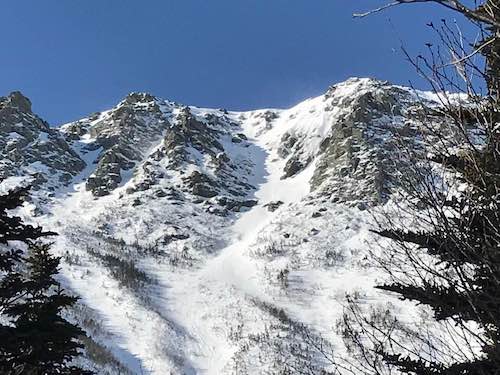A Yankee Notebook
NUMBER 2016
March 9, 2020
Hermit Lake
EAST MONTPELIER, VT – I’ve been to Hermit Lake many times over the years, yet only recently developed a sense of disorientation. I don’t recognize anything, except the trail heading up the so-called Little Headwall to the great bowl of Tuckerman Ravine and, of course, the beetling, east-facing cirque itself, crowned today with a brow of windblown snow. Everything else – all the buildings – have been here for years; but when our group of climbers first started haunting this side of Mount Washington, the only building here that I can remember was the old Hermit Lake Shelter, an oversized wooden leanto. College outing club trips often came here, mostly for the rock climbing on Lions Head and Boott Spur. The shelter held twelve. We often noted that, on coed trips, it held a maximum of twenty-four.
That old structure is long-gone – burned, I think I heard. We all used white gas mountain stoves in those days, and if they misbehaved, there wasn’t much to do but run away and wait for the fire to die down. Now there are multiple buildings, including the US Forest Service quarters we’re using today as our base of operations for the film crew. No running water, but propane heat and electricity. Fairly posh.
The climb to Hermit Lake is noticeable, but not severe –1800 feet of elevation in 2.4 miles over an old tote road now widened a bit for the Pisten Bully Snowcat that ferries supplies and passengers up the lower mountain and sometimes evacuates injured climbers or skiers. The operator keeps a casual count of pedestrians going up or down. Today it was mostly down during the morning: folks who’d spent the night camping after a day of skiing in the bowl. The avalanche danger, according to the USFS announcements posted in the clearing at the head of the climb, is “Low.”
It’s impossible to spend much time at Hermit Lake, looking up at the rim of the great ravine, without remembering and mentioning the almost unbelievable feat of a young native Austrian skier, Toni Matt, who in April 1939 entered the so-called “American Inferno” race, which started on the cone of Mount Washington, plunged over the lip of the cirque, descended the seriously high-angle Headwall, and then entered the woods on the Sherburne Trail, ending finally at Pinkham Notch. Experts only, but Toni was US ski champion that year, as well as an Olympian. Confused by poor visibility high on the mountain, he missed the point at which he was planning to check, and suddenly realized that he was virtually in a free-fall down the headwall, going too fast to even try to check.
Toni schussed straight down, somehow spotted the entrance to the Sherburne Trail, and disappeared into the woods, leaving spectators unable to believe what they’d just seen. His time for the four-mile race cut the previous record in half. In spite of all his subsequent achievements, he was all his life known for that one. Rather like poor Bill Buckner, but for a far different reason. Looking at that almost vertical wall of snow today, it’s still hard to believe.
We’re here today to watch and film a group of kids experiencing a one-day clinic in avalanche training. With the almost exponential growth in outdoor recreation and the equally surprising improvements in equipment, many more folks are testing the limits of their experience and judgment, with a resulting increase in accidents. The sponsor of the clinic is the White Mountain Avalanche Education Foundation, operating in concert with the Forest Service and a passel of volunteers in the familiar red Ski Patrol parkas with the white crosses. A cold, biting wind keeps everybody moving.
The instructors demonstrate the equipment for travel in avalanche terrain – locator beacons, folding shovels, and probes – and give the two victim-hunting search dogs here today a chance to show their stuff. For the kids, this is just an introduction to the subject; there’s no substitute for the judgment and skills they’ll develop if they decide to take mountaineering and skiing to the next steps. But at least they’ll have heard about the mistakes people make in questionable situations.
High above us, in a couloir named Hillman’s Highway (after Harry Hillman, a 1940 Dartmouth graduate who liked to ski there), several ant-small dark figures trudge upward toward the rim of the bowl. They disappear from our sight and shortly come swooping down the 55º-average slope. The snow must be nearly perfect; they throw up big plumes at every turn. Meantime, the parade of skiers from Pinkham Notch, swelled now in the afternoon, comes “skinning” into HoJo’s, the caretaker’s cabin where on bad days you can get out of the rain for a while on the porch, and on good days eat your lunch at a picnic table in the sun, or just sprawl out on a bench by the railing. Come April and May, on good weekends the place will be wall-to-wall with colorful skiduds and a million dollars’ worth of new ski equipment that will remind me more than ever of the number of years gone by since we filled the old shelter at Hermit Lake.

Hermit Lake
Photo by Phil Vaughn

